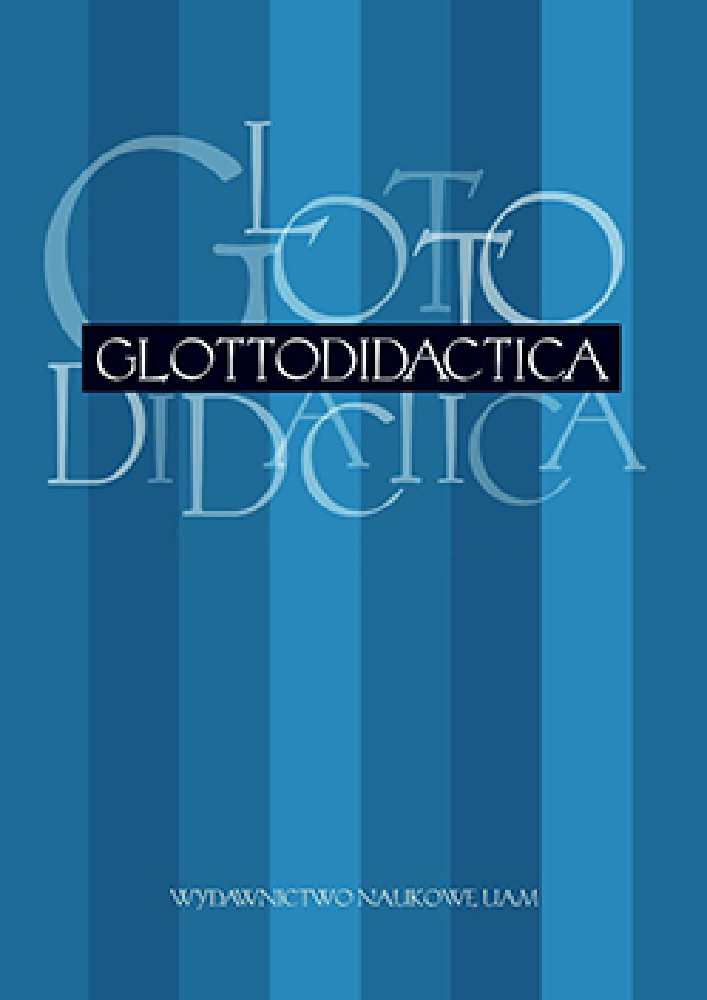Abstract
This study aims at investigating the authenticity of vocabulary and grammar structures included in two selected English language textbooks (hereafter ELTs) and two German language textbooks (hereafter GLTs) for the first stage of education in Poland. In order to achieve the assumed objective, the author examined literary materials, that is, songs, rhymes, or short stories, included in selected ELTs and GLTs in accordance with the principles of the corpus stylistics method developed, for example, by Semino & Short (2004), Mahlberg (2014), or McIntyre (2015). With the support of BYU-BNC and DWDS corpora, the performed analysis indicated, for instance, that in the case of both types of textbooks studied, the number of authentic words that children are to learn seems to be rather insufficient. The outcomes of the study enable suggesting certain modifications targeted at the increase of the authenticity of language that the analysed textbooks include.
References
Biber, D. (2011). Corpus linguistics and the study of literature. Back to the future? Scientific Study of Literature, 1 (1), pp. 15–23.
Bogucka, M. (2014). Program nauczania języka angielskiego zgodny z podstawą programową z 23 grudnia 2008, 27 sierpnia 2012 i 30 maja 2014. Typy szkół: szkoły podstawowe, edukacja wczesnoszkolna. Warszawa: Pearson Central Europe.
Carter, R. (2010). Methodologies for stylistic analysis: practices and pedagogies. In: D. McIntyre / B. Busse (eds.). Language and style. Basingtoke: Palgrave MacMillan, pp. 34–46.
Davies, P. / Graham, C. / Szpotowicz, M. / Szulc-Kurpaska, M. (2016). New sparks 3. Warszawa: Oxford University Press Polska Sp. z o.o.
European Commission / EACEA / Eurydice. (2017). Key data on teaching languages at school in Europe – 2017 edition. Eurydice report. Luxembourg: Publications Office of the European Union.
Ho, Y. (2011). Corpus stylistics in principles and practice. London: Continuum.
Hoover, D. / Culpeper, J. / O’Halloran, K. (2014). Digital literary studies: Corpus approaches to poetry, prose and drama. Abingdon: Routledge.
Iluk, J. (2012). Zasady nauczania dzieci języków obcych metodą narracyjną. In: K. Grzywka (ed.). Kultura – Literatura – Język. Pogranicza komparatystyki. Tom poświęcony Lechowi Kolago. Warszawa: Instytut Germanistyki Uniwersytetu Warszawskiego, pp. 1601–1611.
Kębłowska, M. (2014). Program nauczania języka angielskiego. Kurs dla uczniów klas 1–3 szkoły podstawowej zgodny z nową podstawą programową obowiązującą od 2014 roku. Warszawa: Express Publishing & Egis.
Komorowska, H. (2002). Metodyka nauczania języków obcych. Warszawa: Fraszka Edukacyjna.
Komorowska, H. (2008). Controversies in Teaching English to Young Learners. The Polish Solution. In: M. Dooly / D. Eastment (eds.). How We’re Going About It. Teachers’ Voices in Innovative Approaches to Teaching and Learning Languages. Newcastle: Cambridge Scholars Publishing, pp. 251–261.
Krawczyk, E. / Zastąpiło, L. / Kozubska, M. (2014). ABC Deutsch 3. Warszawa: Wydawnictwo Szkolne PWN.
Krawczyk, E. / Zastąpiło, L. / Kozubska, M. (2015). Ich und du 3. Warszawa: Wydawnictwo Szkolne PWN.
Leech, G. / Short, M. (1987). Style in fiction : a linguistic introduction to English fictional prose. London: Longman.
Mahlberg, M. (2007). Corpus stylistics: Bridging the gap between linguistic and literary studies. In: M. Hoey (ed.). Text, discourse, and corpora: theory and analysis. London: Continuum, pp. 210–246.
Mahlberg, M. (2014). Corpus stylistics: Bridging the gap between linguistic and literary studies. In: M. Burke (ed.). The Routledge handbook of stylistics. London: Routledge, pp. 219–246.
MEN (2014). Podstawa programowa kształcenia ogólnego. https://men.gov.pl/wpcontent/ uploads/2014/08/zalacznik_2.pdf [17.05.2017]
McIntyre, D. (2015). Towards an integrated corpus stylistics. Topics in Linguistics, 16 (1), pp. 59–68.
Rapacka, S. (2012). Program nauczania języka niemieckiego dla klas I– III oraz IV–VI szkoły podstawowej. Warszawa: Wydawnictwo Szkolne PWN.
Semino, E. / Short, M. (2004). Corpus Stylistics. Speech, Writing and Thought Presentation in a Corpus of English Writing. London: Routledge.
Stec, M. (2016). Ilustracja jako narzędzie w materiałach testujących znajomość języka angielskiego u dzieci. In: D. Gabryś-Barker / R. Kalamarz (eds.). Ocenianie i pomiar biegłości językowej. Wybrane aspekty teoretyczne i praktyczne. Katowice: Wydawnictwo Uniwersytetu Śląskiego, pp. 27–42.
Stubbs, M. (2005). Conrad in the computer: examples of quantitative stylistic methods. Language and Literature, 14 (1), 5–24.
Studzińska, I. / Mędela, A. / Kondro, M. / Piotrowska, E. (2015). Program nauczania języka angielskiego zgodny z podstawą programową – Rozporządzenie Ministra Edukacji Narodowej z dnia 30 maja 2014 r. – dla I etapu edukacyjnego, szkoła podstawowa, klasy 1–3. Warszawa:
Macmillan.
Worrall, A. / Lochowski, T. (2015). English adventure 3. Warszawa: Pearson Longman.
Wynne, M. (2005). Stylistics: corpus approaches. http://www.pala.ac.uk/uploads/2/5/1/0/ 25105678/corpora_stylistics.pdf [6.05.2017].
Internet sources
http://corpus.byu.edu/bnc/ [11.05.2017]
http://www.dwds.de/r [11.05.2017]
http://www.pearson.pl/englishadventure/zaczarowane-lekcje
http://www.webcorp.org.uk/live/guide-other.jsp [17.05.2017]
http://www.wszpwn.com.pl/oferta-wydawnicza/jezyk-niemiecki,17,151/ich-und-du-1-3,14074.html [17.05.2017]
License
Authors
Authors of texts accepted for publication in Glottodidactica are required to complete, sign and return to the Editorial team’s office the Agreement for granting a royalty-free license to works with a commitment to grant a CC sub-license.
Under the agreement, the authors of the texts published in Glottodidactica grant Adam Mickiewicz University in Poznań a non-exclusive, royalty-free license and authorize the use of Attribution-NoDerivatives 4.0 International (CC BY-ND 4.0) Creative Commons sub-license.
The authors retain the right to the free disposal of the work.
Users
Interested Internet users are entitled to use works that have been published in Glottodidactica since 2016, under the following conditions:
▪ attribution – obligation to provide, together with the distributed work, information about the authorship, title, source (link to the original work, DOI) and the license itself.
▪ no derivatives – the work must be preserved in its original form. Without the author's consent, it is not possible to distribute the modified work in the form of translations, publications, etc.
Copyrights are reserved for all texts published before 2016.
Miscellaneous
Adam Mickiewicz University in Poznań retains the property right as a whole (layout, graphic form, title, cover design, logo etc.).
Privacy statement
The names and email addresses published on this journal site will be used exclusively for the purposes declared by this journal and cannot be used for any other purpose or by any other party.





